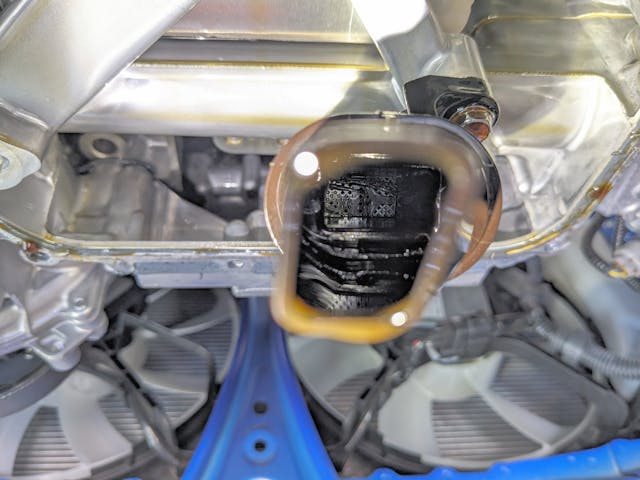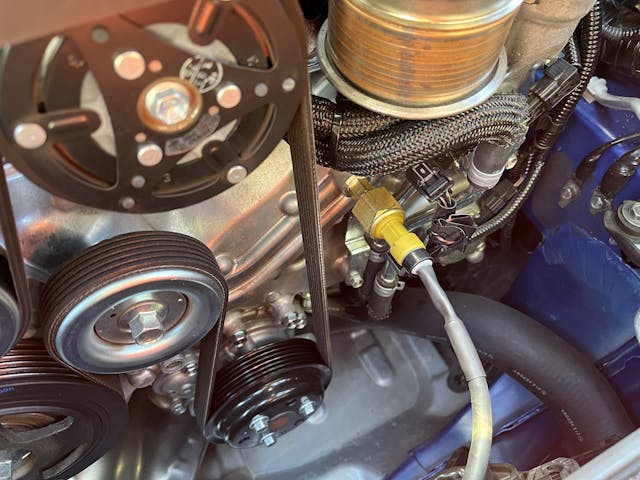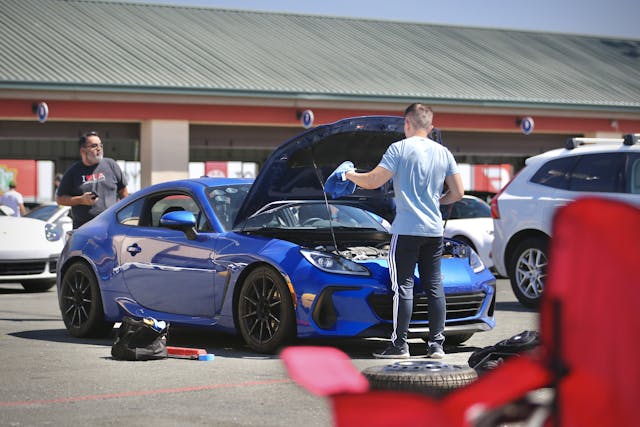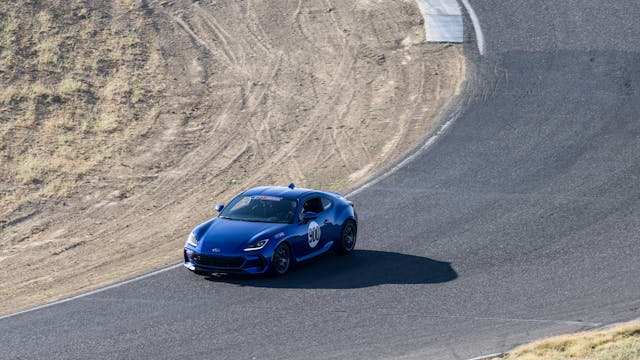Media | Articles
FA24 engine failures don’t daunt the BRZ and GR86 faithful
The Subaru BRZ and its sibling, the Toyota GR86, are among the most compelling affordable sports cars currently on the market. These featherweight, two-door coupes have won legions of fans with their fluid chassis and satisfying manual transmissions. Some owners, however, have experienced significant mechanical failure of their Subaru-built FA24 boxer four-cylinder engines. Numerous reports, forum posts, and videos have circulated online over the last year discussing these instances, which an unknown number of owners have suffered during track and autocross outings. Toyota and Subaru have so far stood by their product and admitted no design or engineering flaws, and they’ve honored warranties in some cases.
None of that has stopped dedicated enthusiasts in the GR86/BRZ community, who are going to great lengths in search of a trustworthy solution. When car people sink their teeth into a problem, they dig in.
Perhaps the highest-profile case of engine failure involved an autocrosser, Arkansas-based Blake Alvarado. After Alvarado’s engine blew during one lap around a cone course in 2022, he brought his car to a Toyota dealership and requested a warranty repair. When Toyota refused to cover his engine rebuild under warranty, Alvarado let the internet know.
While Alvarado’s case was being reviewed, videos of other incidents emerged. Chatter around the GR86’s engine turned into an enthusiast forum firestorm. YouTube user LUNK recorded an engine failure during what appeared to be a fairly tame track outing.
After six months, Toyota rendered a verdict based on its corporate investigation of Alvarado’s issue. The aforementioned dealership had made a mistake, a Toyota spokesperson told Hagerty: “The Toyota dealership service department considered on-track driving as voiding the warranty, since the policy explicitly calls out ‘racing’ to fall under misuse. After further evaluation of the vehicle, it was found that although the vehicle was being driven on a track, it was not ‘raced’ and therefore not misused.”
Later inspection revealed the car had spun a rod bearing. Toyota gave Alvarado the new motor he had requested earlier that year.
Blowing chunks?
It is not entirely clear how many incidents of FA24 engine failure there have been, or even if all said incidents are due to a common issue. Undaunted, die-hard GR86 and BRZ fans nevertheless put their efforts into investigating both causes and potential solutions.
Early on, forum critics suspected the popped engines were the result of oil starvation at the oil pickup, caused by a material known as RTV (room-temperature vulcanizing silicone). RTV is used in manufacturing to seal many components in the engine, like the oil pan, timing cover, heads, and valve covers. A portion of this bonding agent, the thinking went, could come loose inside the engine and make its way into the oil pickup tube. Despite the presence of a strainer inside said pickup tube—which is designed to prevent RTV from circulating in the oiling system—enough RTV could theoretically starve the motor of oil.
With a pick tool and a few hours to clean up any “excess” RTV, proactive DIYers set to work aiming to reduce the risk of oil starvation. However, considering the potential consequences of a job done poorly, more cautious enthusiasts recommend leaving the job to a tech. “I paid an experienced mechanic to do this job because the consequences are dire if you get it wrong,” said Brian Armstrong, a Bay Area–based software engineer who is also a GR86 enthusiast and a meticulous student of the engineering on this car. “You’re working directly on the oiling system, which could cause warranty issues if the work is not done properly,”

Field research
Even for those who had taken steps to remove some RTV, failures continued at a seemingly steady rate. One group of owners went as far as fitting their cars with testing instruments to monitor the oiling systems. By studying the car’s CAN Bus data and the findings from these sensors—plus monitoring via an AiM Solo 2, a respected racing data-logging system—they put together a more detailed picture of what might actually be happening in these on-track engine failure scenarios.
The group consists of a handful of friends from the Bay Area: the aforementioned Armstrong, Miles Kodama, and an owner who goes by the handle NoStreetRacing86. They began a series of on-track tests using a first-gen BRZ, a second-gen BRZ, as well as a second-gen GR86. The newer cars, both fitted with Jackson Racing oil coolers, wore GT Radial Champiro SX2 tires 225/45R17, while the first-gen example had a set of GT Radial Champiro SX2 with 235/45R17 tires.

After testing, here is what Armstrong reported:
“We found the FA24 provides robust oil pressures in most circumstances on straights and left-hand turns. However, in some right-hand turns (particularly those with sustained lateral g, rapid lateral direction change, or elevation change) we can observe and reproduce severe oil-pressure drops.
“We believe these pressure drops are significant enough to cause bearing damage, even if not an immediate failure. We can establish the significance of the pressure drops by describing the typical oil pressure above 4000 rpm as around 60 psi, and we have observed pressure dropping as low as the mid-20s [psi] multiple times per lap.”
The video below suggests that these pressure drops are most frequently seen in fast right turns and over crests, and when engine speeds are above 6000 rpm. Below that, engine oil pressure appears to remain stable.
There is no evidence, however, to suggest that the pressure drops in question are related to RTV blocking the engine oil pickup, said Armstrong.
“We’ve been able to reproduce this across multiple cars, including cars that have had excess RTV removed from their pickup. While we do believe that RTV is still cause for concern, it is a separate problem.”
Fenton Sun, a popular YouTuber better known as Zygrene, had initially suspected that tires with more grip than stock played a role in the failures. “My theory that only cars with high-grip tires were at much higher risk of oil starvation was disproved by Brian’s data, since even cars equipped with GT Radial SX2 tires—which offer similar or even slightly less grip than OEM Pilot Sport 4—see their oil pressure drop below 30 psi in certain right-hand corners.”
Sun owns and tracks his second-generation BRZ, which, fortunately, has not failed him yet. In fact, it’s been a near-faultless car after a dozen track days.

Official response
So far, these grassroots research projects have determined nothing conclusive. And for its part, Subaru disputes any assertion that its FA24 engine suffers from a design or manufacturing flaw. Oil pressure drops, it contends, are not exactly a smoking gun. Here is the automaker’s comment to Road & Track this past June:
Subaru of America stands behind the design integrity of the FA24 engine which is used reliably in thousands of vehicles. Oil pressure varies in all engines based on rpm, temperature, cornering loads and numerous other external and internal factors. This is normal in an engine duty cycle. The FA24 engine is designed to perform within a wide set of tolerances for road use, and the Subaru BRZ is designed as a road car. Race cars are specially modified to be used for race conditions.

Most road cars aren’t designed to handle hard lapping on a race track, at least not without some modification. But what many GR86/BRZ fans took issue with was the seeming dissonance between the cars’ marketing campaign and the room for interpretation in its factory warranty. Marketing videos and advertising images of the car on race tracks—in Subaru’s case, with a racing driver behind the wheel—struck many enthusiasts as endorsements of the cars’ capabilities.
Complimentary NASA track-day passes and one-year memberships with every GR86 purchase seem to point that way, as well. According to the GR/NASA website, Toyota is treating warranty claims for GR Sports cars in the same fashion it approached Alvarado’s case:
The Toyota GR brand is driven by enthusiasts and focused on delivering incredible experiences wherever the driver may take their vehicles, including the closed-course settings for which their vehicles are designed, so long as they are driven in a manner that falls within the terms of the warranty. Each warranty claim is evaluated on a case-by-case basis.
Toyota has recently clarified its warranty policy with regard to track use. Participation in High Performance Driving Events (HPDE), including events sponsored by Toyota or affiliates, or recreation track/off-highway use does not necessarily limit/exclude warranty coverage under the New Vehicle Limited Warranty. However, damage to the vehicle or components that occurs as a result of abuse or misuse of the vehicle while participating in an HPDE or track and off-highway use is not covered.
It isn’t certain where the line is in these cases. How is “misuse” defined exactly?
“We want people to enjoy the cars in the conditions they were meant for. We will stand behind our car and honor our warranty,” said an undisclosed Toyota rep. In any case, warranty claims can be expected to include examining ECUs of failed engines and criteria such as maximum revs, engine hours, temperature, and more.
Owners take on the onus
As always, maintaining a stock setup is one way of adhering to the terms of the factory warranty. Still, some owners are passionately pursuing the source of these engine failures and modifying their cars regardless of the risks, partnering with interested shops, and in some cases making their findings available to the public.
Killer B Motorsport, a reputable Subaru specialist that has worked on EJ-powered Subarus and their oiling systems in the past, has been developing a baffle to add to the OEM oil pan. The goal is to develop an alternative to affected FA24 customers resorting to an Accusump accumulator or an expensive dry-sump system.

Armstrong fitted Killer B’s baffle to his car and studied his findings. “Unfortunately, initial testing of the prototype oil pan did not result in a meaningful improvement of oil performance, so we believe the hypothesis of oil sloshing forward into the timing cover is not at the root of these pressure drops,” he reported.
“We will remain focused on baffles as a first step because they are simple and require no maintenance, so, if we can find a design that works, it should be a good solution for the largest number of people. One of my friends in our local track community, a mechanical engineer, is currently designing a baffle and partnering with a performance motorsports company to have it produced. We’re hoping to test a prototype of that product in September.”
All of this scrutiny and testing from across the enthusiast base, Armstrong says, is sure to produce a solution. “The goal is to be able to continue to enjoy this car on the track for years to come … Any company which is willing to subject their products to rigorous testing and share the results directly with the community should be celebrated.”

***
Marketplace
Buy and sell classics with confidence
Check out the Hagerty Media homepage so you don’t miss a single story, or better yet, bookmark it. To get our best stories delivered right to your inbox, subscribe to our newsletters.


















I’ve been considering a GR86 as a weekend, autocross and occasional track day car, but these oil pressure issues do give me pause.
The issues seem similar to that of Porsche’s M96/M97 engine series. Both engines were claimed by Porsche to have “dry sump” oiling, but really all they had was significant baffling from the factory and swirl pots to reduce aeration. As many 986/987.1 and 996/997.1 owners found out, the oiling systems were not up to track duty, with similar low pressure in certain conditions. Some owners replaced engines, only to have the next ones blow up in short order. The Turbos, GT3s, GT2s, etc that were designed for track use all had true dry-sump oiling systems.
Many owners fitted deeper oil sumps, extra baffles, etc, to largely no effect. I expect a similar scenario with the FA24 engines. Porsche never did anything about the non-dry-sump M96/M97 engines and I don’t expect Subaru or Toyota to do anything about the FA24.
Subaru has a history of oil-related issues with their boxer-engine design. They also have a history of pushing back until they are forced into action. Keeping track of oil consumption in our 2014 Forester with 98,000 miles is one of my new retirement hobbies. I know “apples and oranges” based on the type of driving and driver, but there is a common factor. Keep the pressure up (Pun very much intended) on Subaru.
Subaru reliability has gone down as the popularity of their cars/sales have gone up. My guess is the quality control isn’t as good as it used to be. My dad had an Turbo EJ motor Forester XT that developed massive oil consumption issues. He dumped it quick when that happened.
Your comment is awaiting moderation. – again
These guys have a few recommendations to keep the oil pressure more stable in the new BRZ/GR86.
https://youtu.be/T_GV_fX-XY4?si=ss-wISM5a4MpXUz_
I own one of the well-known Subaru tuning firms in the industry.
BRZ’s had known issues since day 1.
We jokingly refer to them as having glass rods, and paper bearings, as well as other issues.
Daily we talk people through this, and sell a lot of replacement motors. We have a customer on their 4th OEM motor.
The only way to fix the issues is to upgrade the internals.
Miata is better
The amount of cars that have been documented cases across all social media is in the single digits. There are THOUSANDS of these cars on the road. And a high percentage of them see track duty to some degree. The actual percentage of BRZ\86 engine failures is far less than your average hyundai\kia product. You only hear about it in this case because the BRZ\86 are hot cars with a following. Nobody cares about the econo shit boxes that blow up daily.
The millions of people who drive Subaru econo feces containers care very much.
My 2023 BRZ engine just failed yesterday, I was mildly driving at 60, and I suddenly saw the engine bay was smoking. The engine oil is leaking. I just towed it to the dealership, wait for response. Never went to track, and only has 13k miles on it, I know this car is not good, so never went to track, still failed.
OIL pressure varies in ALL cars while they are being used. The scope of this entire article is a non issue. The failure rate on these engines is below the failure rate that was predicted by third party actuaries(the insurance people). The manufacturer actually has a policy with an insurance company to cover the claims on products sold. This is actually common and mandatory, in some markets, for anyone or any business who makes products to sell to anyone else for money. The internet is wonderful for whipping up furer over NOTHING. NEXT CLICK BAIT PLEASE!
I’m curious how any issues with the NA, high octane/high compression FA24s (BRZ) compare with that of the turbocharged, regular octane FA24s seen in the late model Outbacks. They seem to have similar top torque hp outputs with the RPMs lower overall in the latter engines. A comparison of failures might be revealing. I’m new to this topic, and auto engineering in general, so please forgive me if I don’t make sense.